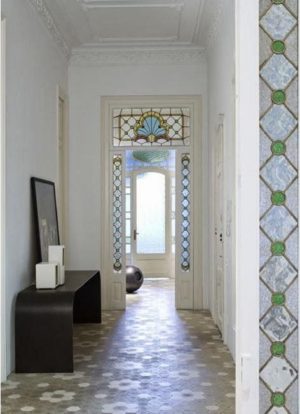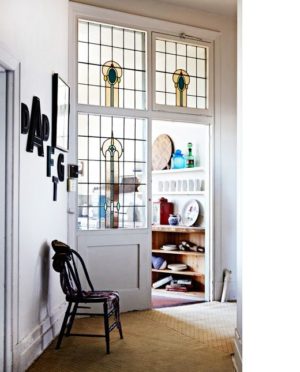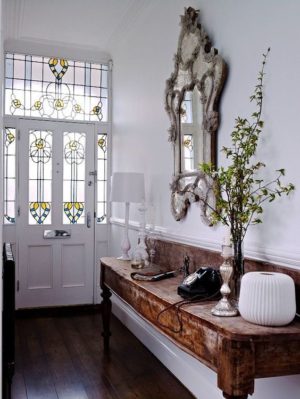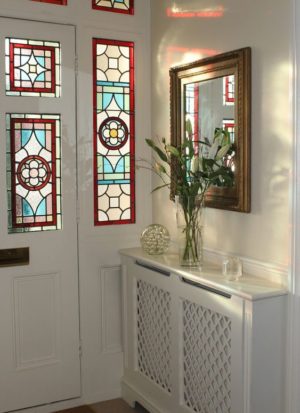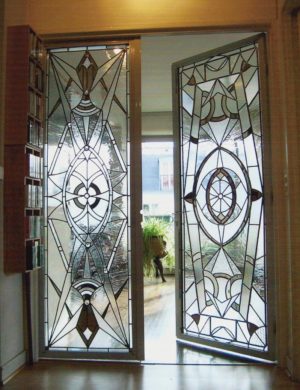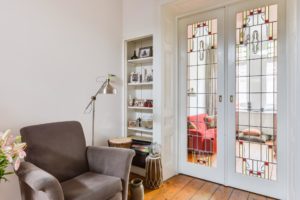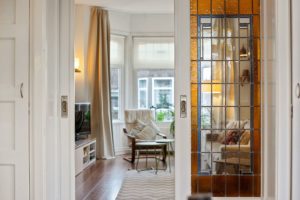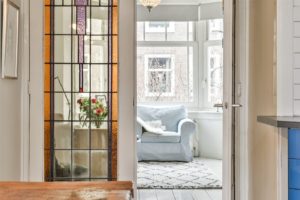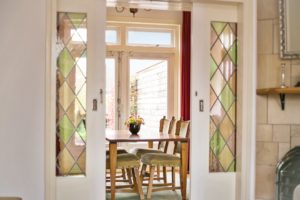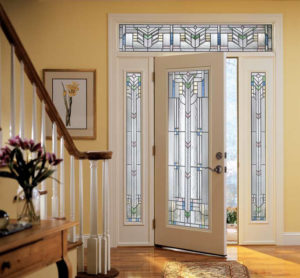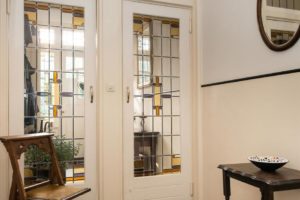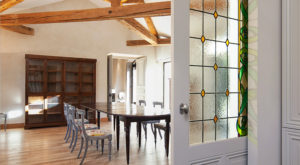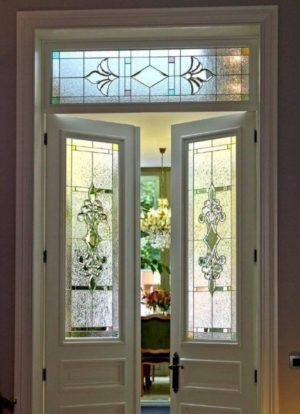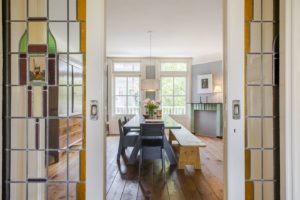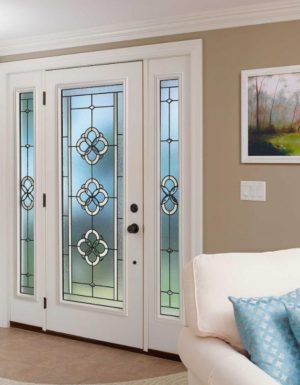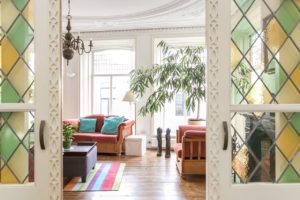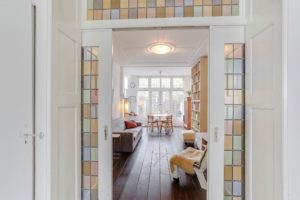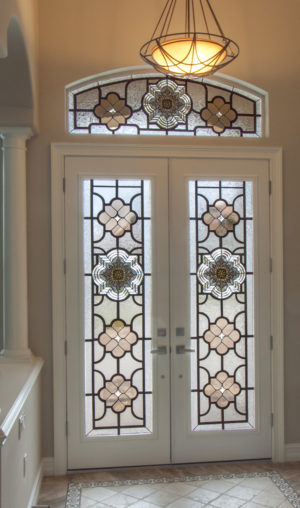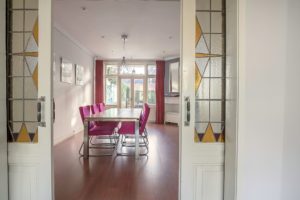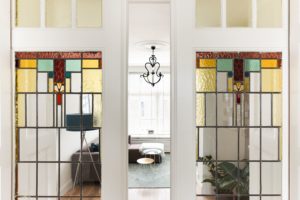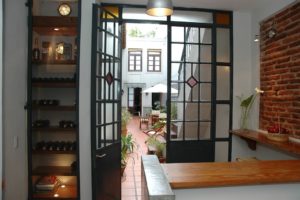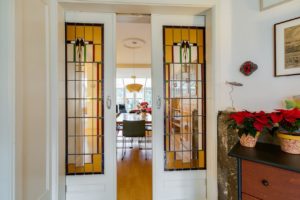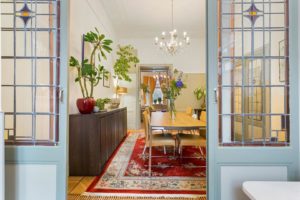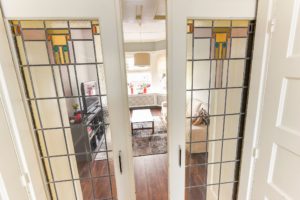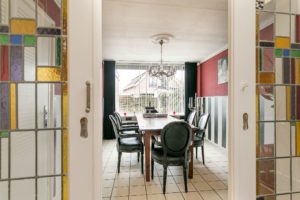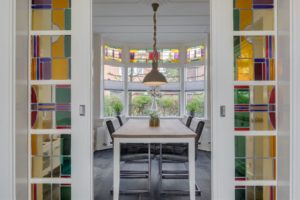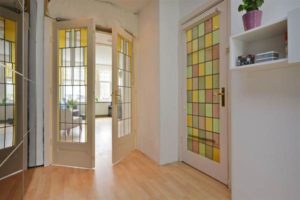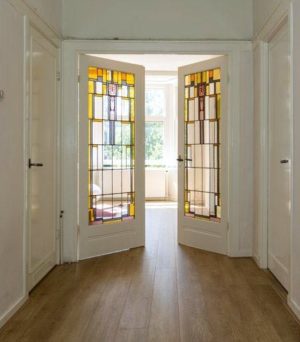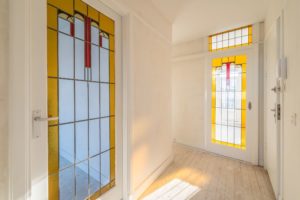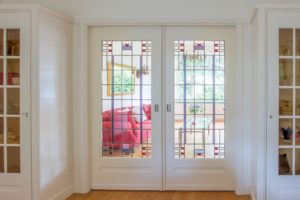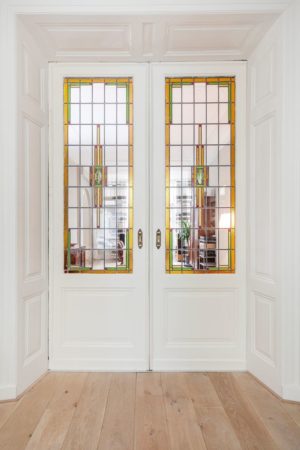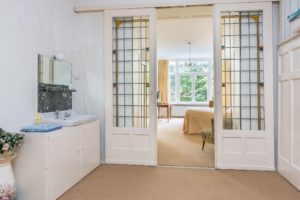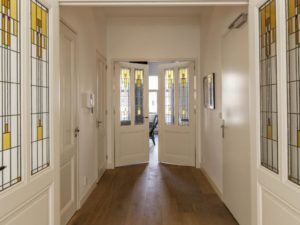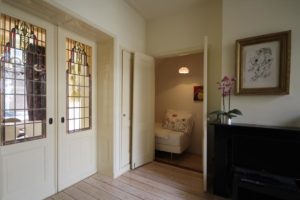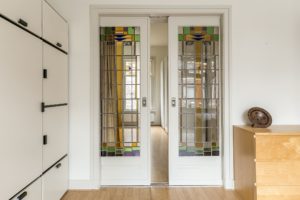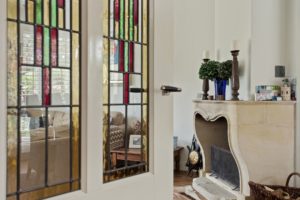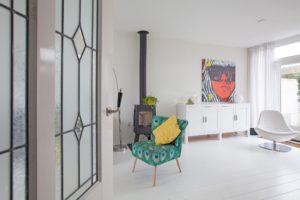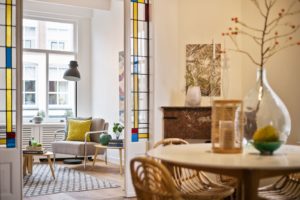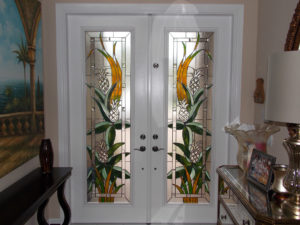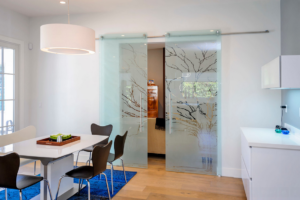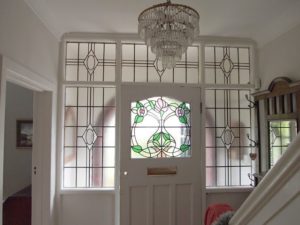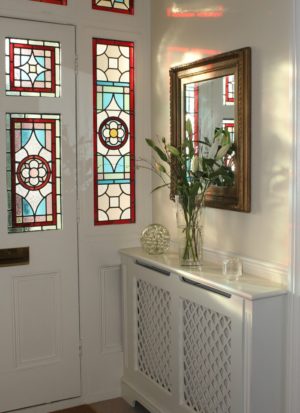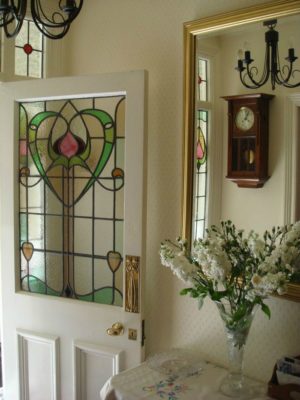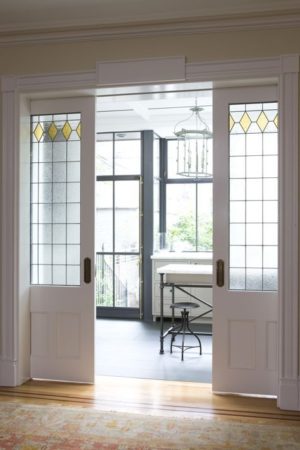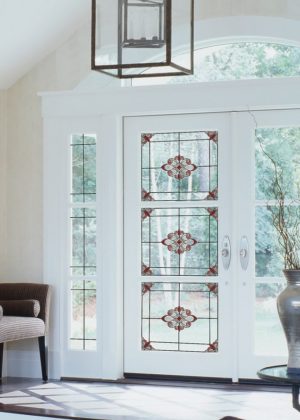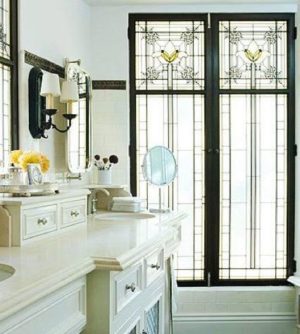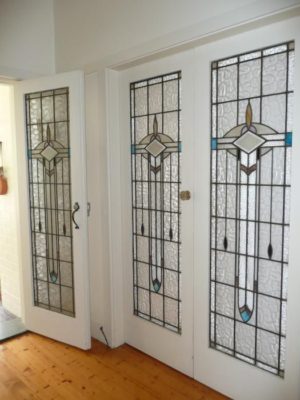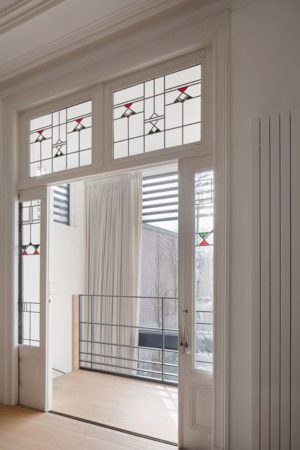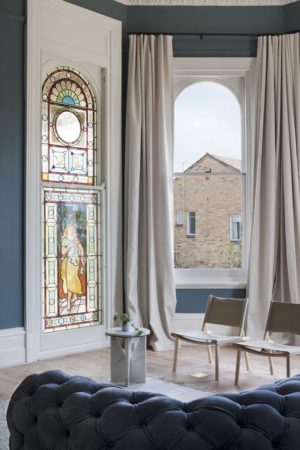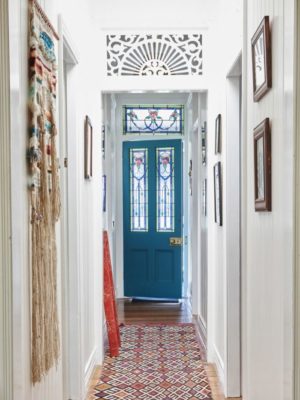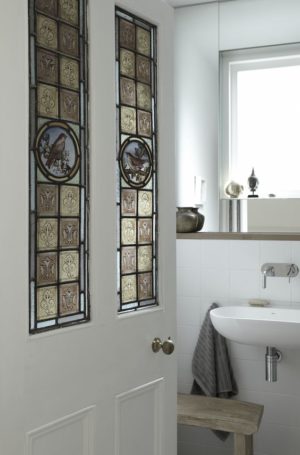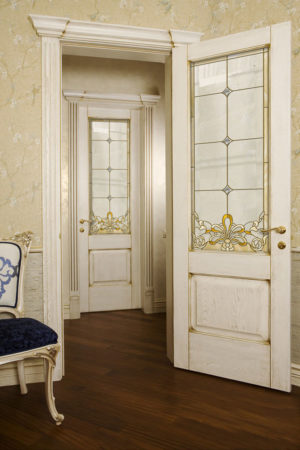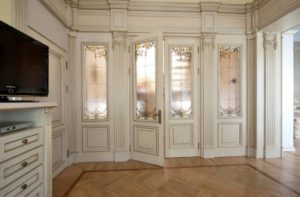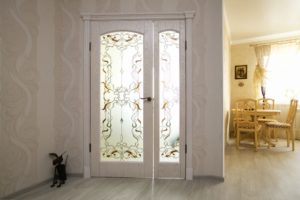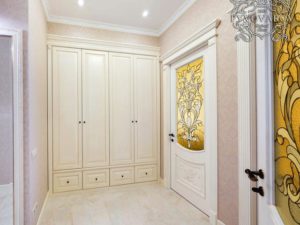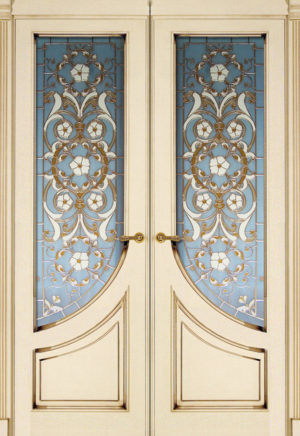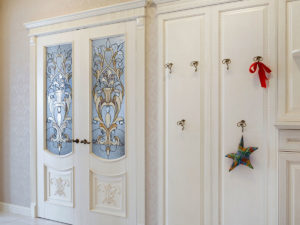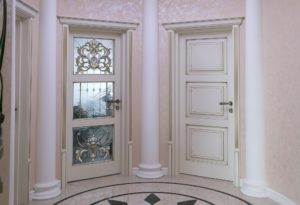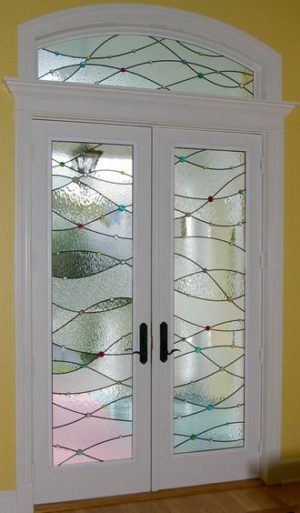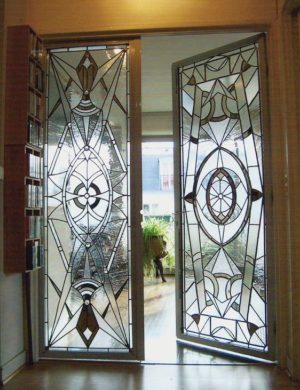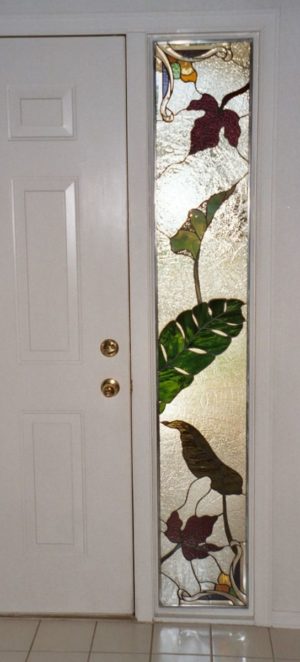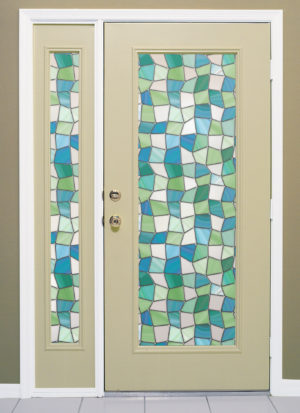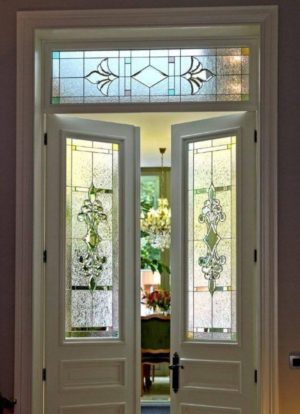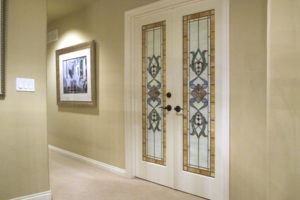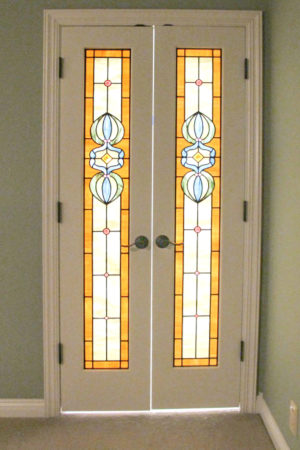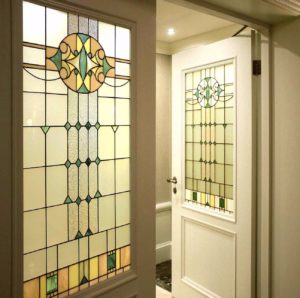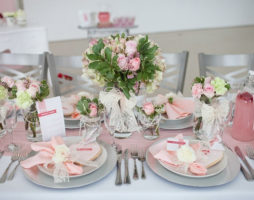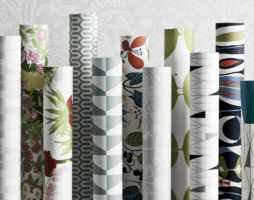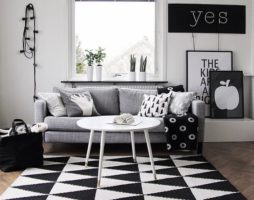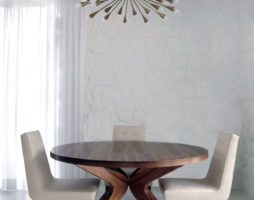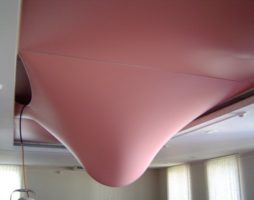Under the influence of technological progress, the design of furnishings and decor is updated daily, capable of transforming the appearance of the environment. But decorators to this day have not managed to create something more magnificent looking than stained glass doors in the interior. Multi-coloured mosaic decor on glass inserts magically colors the light streams and creates an iridescent atmosphere in the room.
- Stained glass doors in the interior: application variations
- Stained Glass Door Techniques: The Basics of Tiffany and Fusing
- Design of doors with flooded and sandblasted stained glass windows
- Budget ways to decorate stained glass doors
- Stained glass door modifications
- The value of stained glass doors for interior composition
- Photo gallery - stained glass doors in the interior
- Video
Stained glass interior items embody the aesthetics of the Gothic stylistic concept. If during the Middle Ages, glass mosaic adorned cathedrals and castles as a priority, today designers are actively using it to give an artistic look to apartments and country houses. Stained glass doors in the interior emphasize the individuality of design, form unique graphic accents. With their help, it will be possible to recreate the atmosphere of medieval luxury associated with the decoration of glass furnishings with masterpieces of constructive and visual art.
back to index ↑Stained glass doors in the interior: application variations
The idea of forming compositions from multi-colored glass elements due to various execution techniques has become an epoch-making cult in architecture and interior design. Temporarily forgotten colorfully decorated glass canvases today once again belong to the palm among the delights of interior fashion. Stained glass mosaic presentably solos in the design of entrance, interior, furniture doors of compartment type. For the decoration of glass parts, all kinds of plots with features of different areas of art are used:
- cubism;
- abstractionism;
- charts;
- animalistics;
- pastorals;
- landscape style;
- surrealism.

Stained glass doors in the interior
Various themes of mosaic images on glass for stained glass doors allow you to organically complement the interior with similar elements of decor or furnishings. Illustrations of animals and birds on transparent canvases are uniformly echoing the horns and skins of animals, furniture upholstery to match the color of a zebra, tiger or leopard. Compositions with graphic images, decorated with a monochrome palette of colors and rectilinear details, perfectly complement the aesthetics of laconic high-tech. Stained glass doors with drawings in the style of cubism are unanimously consistent with the manner of modern modernism, which promotes every manifestation of complex geometric shapes in furniture and decoration. Regardless of the plot of the picturesquely designed composition on glass, a standard door leaf will turn into a true work of art, effectively decorating the interior of any room.
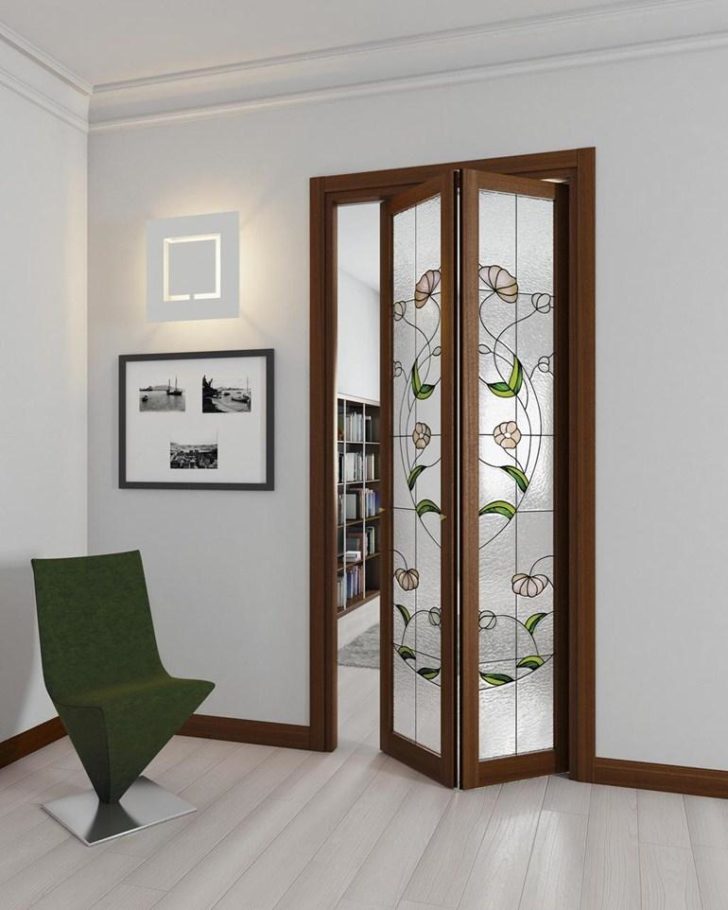
The stained glass door will organically complement the interior in any style.
Stained Glass Door Techniques: The Basics of Tiffany and Fusing
The appearance of stained glass doors is strikingly different from each other due to different techniques for giving the glass the effect of a picturesque painting:
- Tiffany way used to create classic stained-glass windows, involving filigree cutting of glass elements, turning, forming contours from copper or brass foil, and soldering them together. The metal frame of the composition firmly holds the many-sided mosaic placers, which form delightful pictures in the door frame. For a static chic stained glass decor, double-sided coating with thin layers of transparent glass is used. This makes the door leaf heavier, but protects it from deformation as a result of drafts, improves sound insulation and simplifies maintenance.

Stained glass decor in tiffany style
- Fusing technology forms delightful overflows of different colors without separators in the form of a metal frame. Diverse colors create a gradient effect - blurry transitions between the details of a monolithic composition, visually reminiscent of watercolor paintings. A similar decor on glass is made by firing it in a melting furnace, where multi-component elements of different colors are melted and form a single canvas. The result is dynamic abstractions on stained glass doors and partitions. The fusing technique, in addition to masterfully decorating the transparent base, allows you to experiment in every possible way with its texture: to form relief on glass, to perform color engraving by interspersing colorful granules, molding and embossing, painting by adding metal chips.

Dynamic abstractions in fusing technique
In ancient times, the process of forming mosaic pictures from colored glass fragments was equated to filigree jewelry art. Compositions embodying the faces of saints, romantic sketches, images of mythological characters were assembled just as carefully and for a long time. The labor-intensive methods of stained glass decor have improved so much since the Middle Ages that in modern times the most complex multi-component sketches are easily transferred from paper to glass.
back to index ↑Design of doors with flooded and sandblasted stained glass windows
Imitation of stained glass patterns on the door leaf is created by drawing the contours of the image in one color with an admixture of metallic powder and filling it with various colors. Such a painting can easily be done by anyone who wants to transform inconspicuous glass doors.
To do this, you need to draw a sample illustration yourself or pick up a ready-made stencil. Based on the layout, transfer the outlines of the drawing and paint in the desired colors. When choosing paints, you should choose quick-drying waterproof types, for example, alkyd. To prevent the painting coating from being erased as a result of frequent wet cleaning, it is reasonable to cover the colorful image with acrylic varnish.
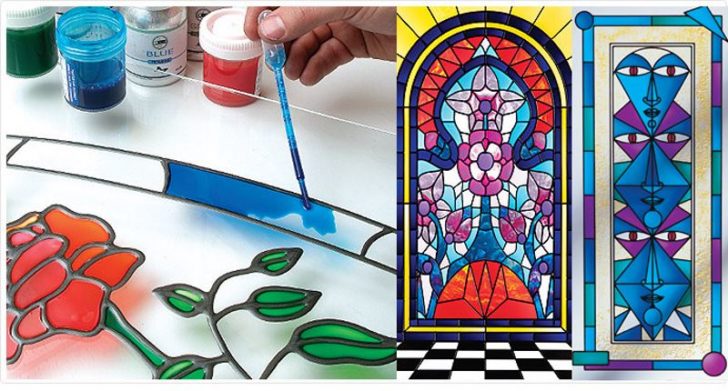
A stained-glass window can be made by hand
Interior doors with stained glass made in sandblasting technique look original. Its principle is to decorate a transparent or matte base by drawing an image with fine-grained sand, removing a layer along the contour of the picture to a certain level of depth.
The main difference between the sandblasted decor is the integrity of the glass canvas, decorated with discreet stained glass illustrations. In interiors, such a decorative design is optimally suited to large-format sliding doors that can transmit light as much as possible. Weightless structures with barely noticeable outlines, thanks to the decor, create a feeling of airiness, visually hide the conditional boundary between the rooms. Such a visual effect cannot be achieved when installing other door modifications: massive metal or wood panels.
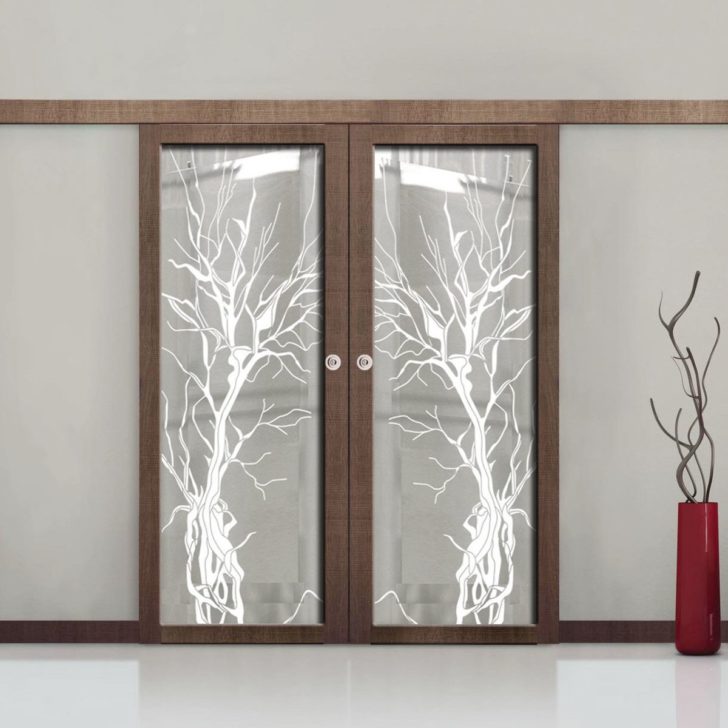
Sandblasted stained glass creates a feeling of airiness
Budget ways to decorate stained glass doors
The complexity of the design of mosaic compositions on glass determines the cost of products. Sandblasting, fusing, painting and Tiffany stained glass belong to the premium segment. Economical ways to decorate doors with colorful illustrations include:
- Pseudo stained glass windows decorated with lavsan films, decorated with imitations of mosaic compositions. The transparent base with artistic illustration is resistant to moisture and sharp temperature fluctuations. Such stained-glass doors in the interior of a bathroom or kitchen retain their original appearance for a long time, regardless of high humidity. Over time, the film base can be easily removed from the glass insert or canvas. This will allow you to quickly and economically modify the design of the door if you want to change the style of the interior or update its familiar look.
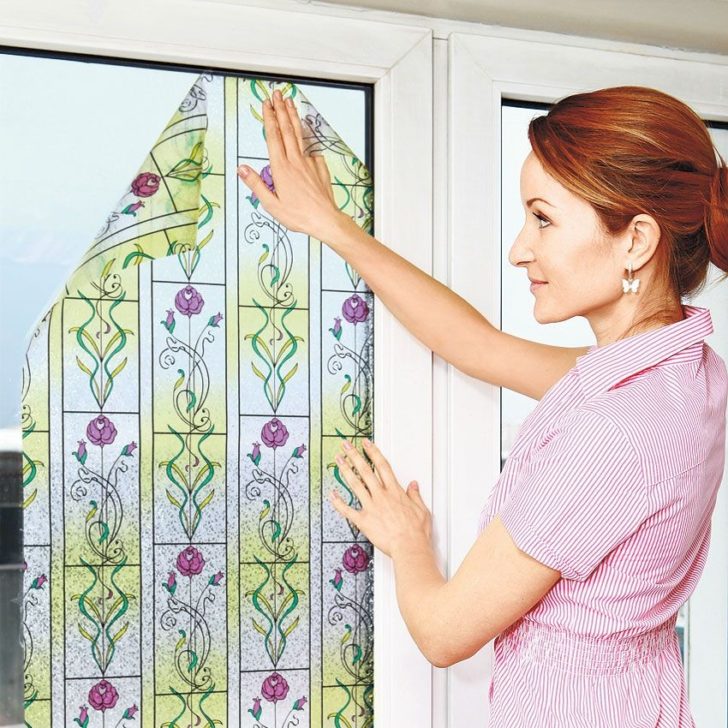
Stained glass drawing on a film basis
- photo stained glass windows perfectly copy skillfully executed stained glass paintings due to the unlimited possibilities of printing in 3D format. Any desired image, a reproduction of the composition of the famous designer Louis Tiffany or other decorators who have contributed to the design of noteworthy architectural structures, can decorate the door leaf. With the appearance of such majestic-looking compositions in an unremarkable room, the interior will instantly be perceived as an original art object.

Photo stained glass copies any desired image
If you want to add a personal touch to the design of the doors, it is advisable to order a glass insert of the right size and create a unique decor yourself. On a transparent basis, it is necessary to draw the outline of the mosaic composition. Cut out fragments of the pattern from colored blanks. Sand the edges and carefully glue. The hand-made process is reminiscent of picking up a picture from numerous glass puzzles. Home-made stained-glass doors in the interior will certainly delight others, create the feeling of being in an aristocratically decorated apartment with an emphasis on picturesque decor.
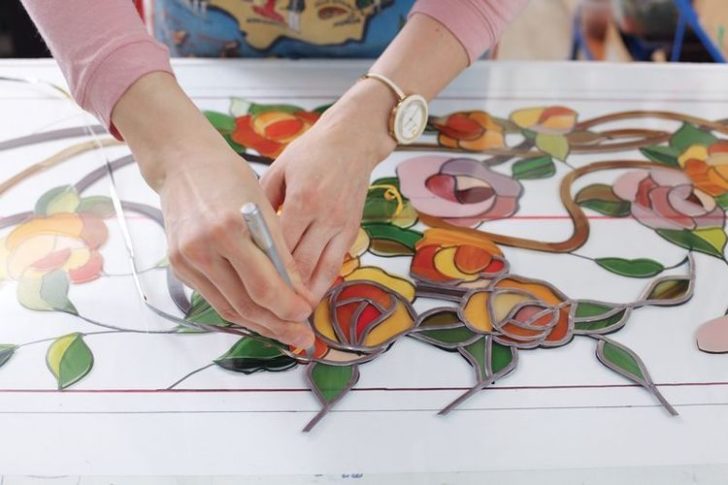
You can create your own unique stained glass window
Stained glass door modifications
Colorfully decorated glass surfaces can act as inserts in plastic, wood or metal structures. Depending on the combined materials, the performance characteristics and aesthetic appearance of the doors are determined:
- The wooden framing of the stained-glass decor details perfectly matches the glass insert. For its fastening, inconspicuous glazing beads or expressive-looking panels with a corrugated surface are used. The inimitable appearance of wood and picturesquely designed glass can be spoiled due to cracking of the door structure under the influence of excessively dry or humid air. To prevent deformation of a wooden door, it is reasonable to choose a model with a base intensively impregnated with moisture-proof compounds. The colors of the stained glass decor are protected from fading and erasing by fixing with several layers of varnish. If the door frame and leaf are made of wood-based materials (chipboard, MDF or HDF), then you should familiarize yourself with the indicator of the maximum weight load. Heavy and massive glass with stained-glass windows is incomparable with a fragile frame made of wood derivatives.
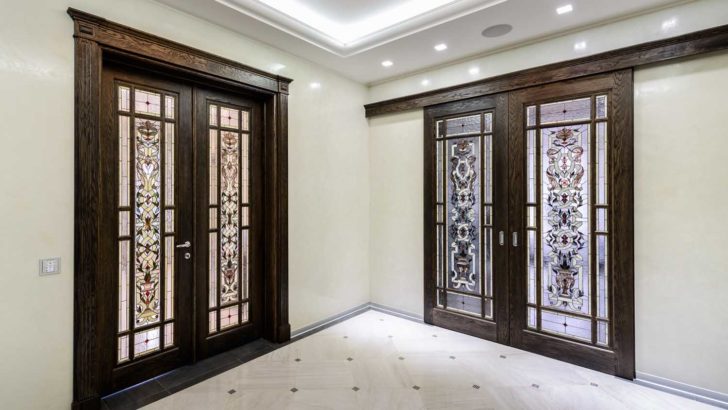
Wooden framing of stained glass decor details
- The plastic frames allow the integration of lightweight small format inserts. The polymer base will not withstand bulky tempered glass decor.It is important to install typical doors interspersed with stained glass elements in rooms with a humid environment: bathrooms, swimming pools, spaces with an indoor fountain or a multi-liter aquarium, which forms a constant evaporation of water.
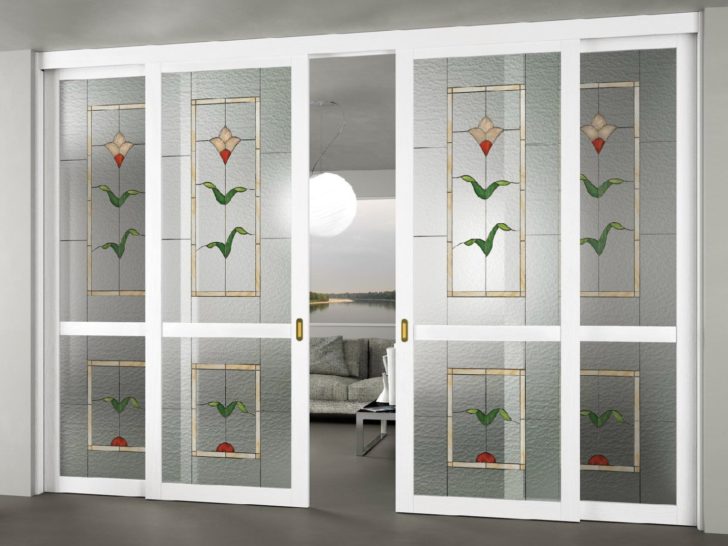
Plastic doors with stained glass elements
- Metal frames will reliably withstand large glass inserts with a cast lead or copper profile, which acts as the basis of the stained glass composition. Monumental-looking doors are often installed at the entrances to mansions, private houses, country estates, restaurants, hotels and other establishments with the goal of making an unforgettable visual impression.. Due to the interaction with the outdoor environment with adverse atmospheric phenomena, the mosaic-shaped elements are equipped with several protective layers of impact-resistant glass. This eliminates the likelihood of their deformation due to mechanical stress, the penetration of cold air and moisture into the room during rain or snow.

Metal frames will reliably withstand glass inserts
- Single-leaf or sliding glass doors are the perfect basis for creating a mosaic decoration. The similarity of the artist's canvas is great for painting stained glass paintings with all sorts of plots. Frameless models attached to the ceiling and floor with rail-type profiles look incredibly beautiful and weightless. To highlight the air effect of levitation, it is reasonable to supplement them with transparent wall partitions from plexiglass or glass blocks interspersed with colored decorative elements. For stability, stained glass doors are framed with a metal or wooden frame.

Sliding glass doors with stained glass decor
The value of stained glass doors for interior composition
Thanks to the transparency of the structures used to fill the doorways, a windowless hallway or corridor looks light and magically colorful. Multi-colored chiaroscuro effectively decorate the room with all the colors of the rainbow. Actual for wall decoration in the hallway with glass interior doors, use light facing materials or mirror Wall panelsreflecting the unique outlines of stained glass decor. An outstanding design solution will create a theatrical entourage in the interior, symbolizing the artistic vision of the surrounding world by the homeowners.

Stained glass inserts decorate the interior with all the colors of the rainbow
The priority advantage of door panels skillfully decorated with mosaics is the easy implementation of space zoning without a global redevelopment. Lightweight glass structures of insignificant thickness soaring in the air will skillfully delimit a studio-type room into separate parts. Images on decorative inserts can look in tune with illustrations on panels, paintings, stretch ceilings, frescoes or airbrush decorations on the walls.
Due to the transparency of the stained glass doors, the effect of a closed space or a feeling of intimacy in a cramped room is leveled.. If a small space in every possible way denies prints, drawings on finishing or decor elements, then illustrations on glass inserts fully compensate for their lack. Models of the compartment type with mosaic decoration in the closed and open state comprehensively demonstrate the splendor of stained glass decoration.
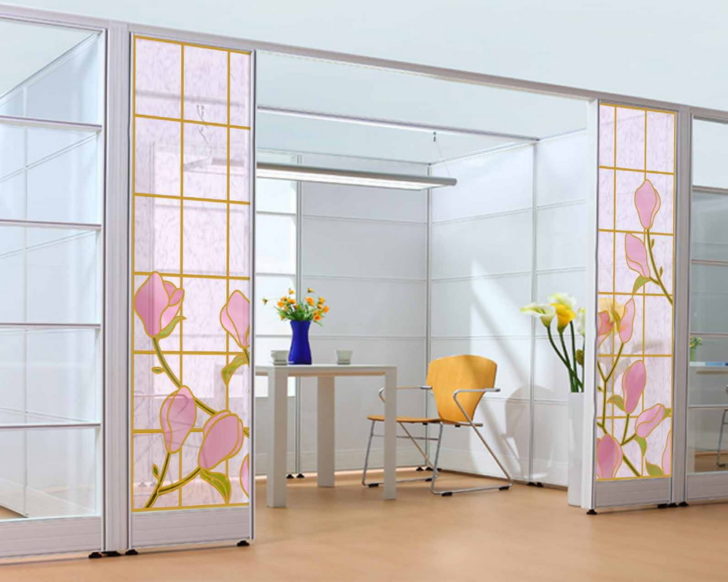
Stained glass doors for space zoning
Of course, the multicolored design of the door leaf will become the visual center of any interior composition.. Bright decoration will add dynamism, liveliness, expressive color to the environment, which arouses interest even among those who have always been indifferent to the fine arts. In order to prevent the formation of the effect of a museum atmosphere, stained glass doors in the interior should be consistent in brightness, size and texture with the color palette, geometry and decor of the surrounding furnishings.

Bright stained glass will add dynamism to the interior
The revival of ancient stained glass art has a beneficial effect on interior design. Stylists have found wide application for colorfully designed glass masterpieces, recognizable not only in the decoration of doors, but also in the design of wall partitions, lighting equipment, mirrors, skins, furniture facades and other interior details. In tune with the LED backlight, the picturesque compositions literally come to life before our eyes and convey to those around us the idea of a stained-glass artist who is able to give ordinary glass a unique shape and inimitable images.
back to index ↑Photo gallery - stained glass doors in the interior
Video
